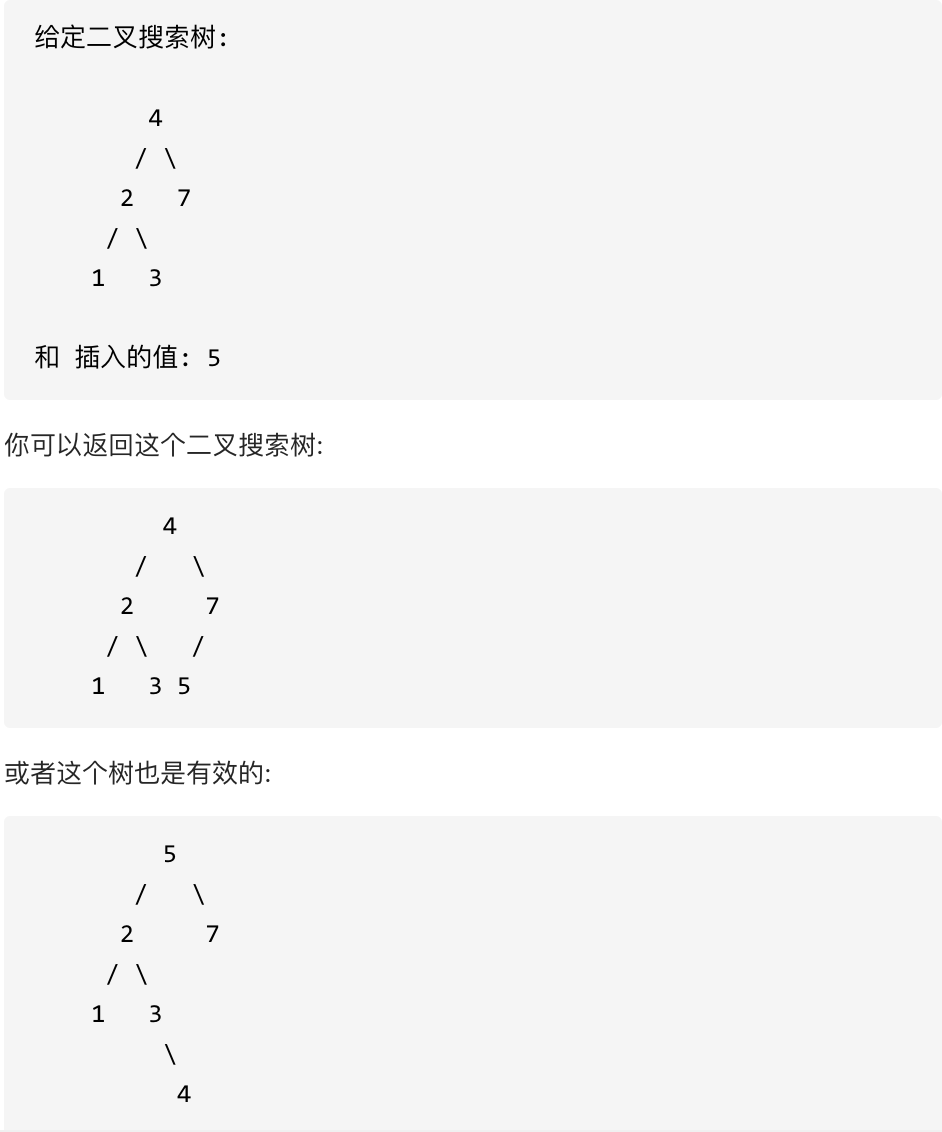代码随想录Day 22 235. 二叉搜索树的最近公共祖先 | 701.二叉搜索树中的插入操作 | 450.删除二叉搜索树中的节点
235 二叉搜索树的最近公共祖先
给定一个二叉搜索树, 找到该树中两个指定节点的最近公共祖先。
百度百科中最近公共祖先的定义为:“对于有根树 T 的两个结点 p、q,最近公共祖先表示为一个结点 x,满足 x 是 p、q 的祖先且 x 的深度尽可能大(一个节点也可以是它自己的祖先)。”
例如,给定如下二叉搜索树: root = [6,2,8,0,4,7,9,null,null,3,5]
因为是有序树,所有 如果 中间节点是 q 和 p 的公共祖先,那么 中节点的数组 一定是在 [p, q]区间的。即 中节点 > p && 中节点 < q 或者 中节点 > q && 中节点 < p。
class Solution { public TreeNode lowestCommonAncestor(TreeNode root, TreeNode p, TreeNode q) { if (root == null || root == p || root == q) { return root; } int rootVal = root.val; int pVal = p.val; int qVal = q.val; if (rootVal > pVal && rootVal > qVal) { return lowestCommonAncestor(root.left, p, q); } else if (rootVal < pVal && rootVal < qVal) { return lowestCommonAncestor(root.right, p, q); } else { return root; } } }
701.二叉搜索树中的插入操作
给定二叉搜索树(BST)的根节点和要插入树中的值,将值插入二叉搜索树。 返回插入后二叉搜索树的根节点。 输入数据保证,新值和原始二叉搜索树中的任意节点值都不同。
注意,可能存在多种有效的插入方式,只要树在插入后仍保持为二叉搜索树即可。 你可以返回任意有效的结果。
算法

/** * Definition for a binary tree node. * public class TreeNode { * int val; * TreeNode left; * TreeNode right; * TreeNode() {} * TreeNode(int val) { this.val = val; } * TreeNode(int val, TreeNode left, TreeNode right) { * this.val = val; * this.left = left; * this.right = right; * } * } */ class Solution { public TreeNode insertIntoBST(TreeNode root, int val) { if (root == null) return new TreeNode(val); if (root.val < val) { root.right = insertIntoBST(root.right, val); } else if (root.val > val) { root.left = insertIntoBST(root.left, val); } return root; } }
450. 删除二叉搜索树中的节点
给定一个二叉搜索树的根节点 root 和一个值 key,删除二叉搜索树中的 key 对应的节点,并保证二叉搜索树的性质不变。返回二叉搜索树(有可能被更新)的根节点的引用。
一般来说,删除节点可分为两个步骤:
- 首先找到需要删除的节点;
- 如果找到了,删除它。

- 第一种情况:没找到删除的节点,遍历到空节点直接返回了
- 找到删除的节点
- 第二种情况:左右孩子都为空(叶子节点),直接删除节点, 返回NULL为根节点
- 第三种情况:删除节点的左孩子为空,右孩子不为空,删除节点,右孩子补位,返回右孩子为根节点
- 第四种情况:删除节点的右孩子为空,左孩子不为空,删除节点,左孩子补位,返回左孩子为根节点
- 第五种情况:左右孩子节点都不为空,则将删除节点的左子树头结点(左孩子)放到删除节点的右子树的最左面节点的左孩子上,返回删除节点右孩子为新的根节点。
![]()
-
/** * Definition for a binary tree node. * public class TreeNode { * int val; * TreeNode left; * TreeNode right; * TreeNode() {} * TreeNode(int val) { this.val = val; } * TreeNode(int val, TreeNode left, TreeNode right) { * this.val = val; * this.left = left; * this.right = right; * } * } */ class Solution { public TreeNode deleteNode(TreeNode root, int key) { root = delete(root, key); return root; } private TreeNode delete(TreeNode root, int key) { if (root == null) return null; if (root.val > key) { root.left = delete(root.left, key); } else if (root.val < key) { root.right = delete(root.right, key); } else { if (root.left == null) return root.right; if (root.right == null) return root.left; TreeNode tmp = root.right; while (tmp.left != null) { tmp = tmp.left; } root.val = tmp.val; root.right = delete(root.right, tmp.val); } return root; } }



 浙公网安备 33010602011771号
浙公网安备 33010602011771号